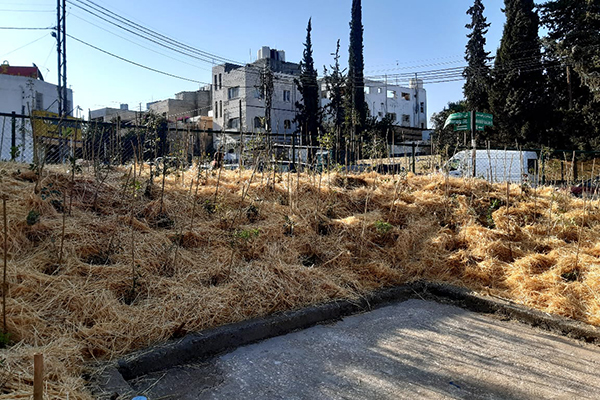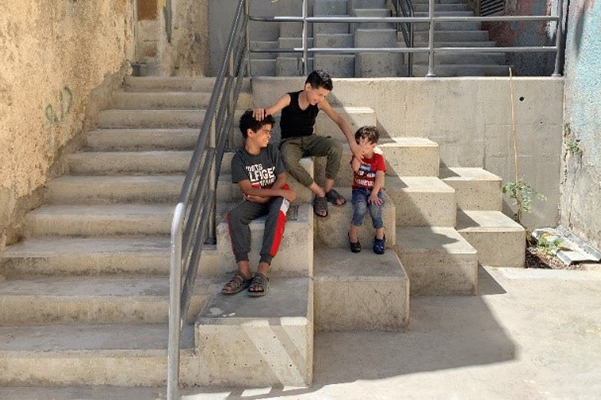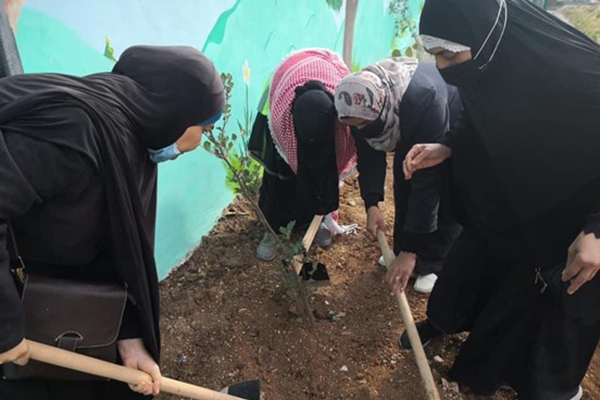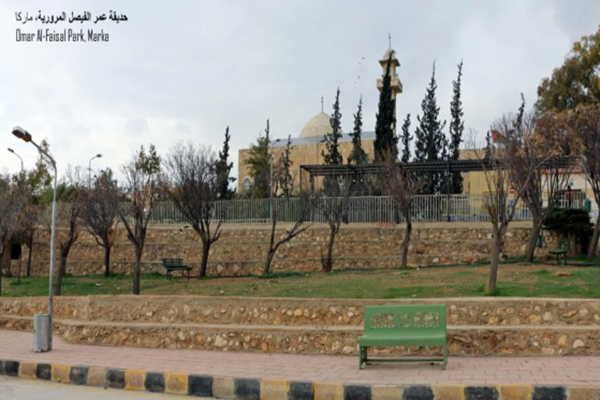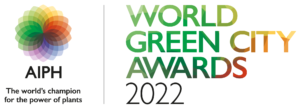Addressing the urban challenge
Breadth of the issue – How are the problem(s) that are being tackled by your initiative affecting citizens/local businesses or a significant component of the local wildlife?
Amman’s population has doubled since 2004 and reached about 4 million in 2015. This unexpected fast growth of Amman caused many problems, especially in the densely populated poorer areas of Amman that suffer from population pressure. The overstressed infrastructure cannot cover people’s demands. Public space like squares, free areas/open space, playgrounds and walking path and sidewalks – parts of green infrastructure – degrade noticeably. Networks of open spaces and walking paths connections are by now very reduced. Social cohesion and integration are limited due to the lack of interaction possibilities in the neighbourhoods. The accesses to public transport are not attractive and only limited alternatives to motorized transport exist. Access to workplaces, supermarkets, social facilities such as kindergartens, schools and health facilities is therefore difficult. It is essential to have a convenient and safe access to public transport system to fulfil for example the national climate targets (NDC) set out in the Paris Agreement. Most residents in the poorer districts of Amman, especially women, do not have access to motorized transport. Many women in poorer parts of Amman depend on non-motorized transport, expensive taxis, or buses. The value of green infrastructure and its role in improving walkability, movement within a neighbourhood and beyond via improved access to public transport and social amenities (such as parks, playgrounds etc.) and in achieving the national and global development targets is still not familiar to many Jordanians.
Depth of the issue – How seriously are the problems being tackled by your initiative impacting the life of the citizens/businesses/wildlife concerned?
Largely due to migration from conflict-prone neighbouring countries, the population of Jordan’s capital Amman has doubled from 1.9 million in 2004 to over 4 million in 2015. Most new dwellers settle in the dense and poorer eastern parts of the city, overstretching the capacity of an already insufficient infrastructure. This rapid urbanisation has brought with it the challenges of high density, concrete-dominance and little to no access to public and green spaces. Covering only around 2.5 percent, the low proportion of urban green spaces places additional pressure on the remaining biodiversity, contributes to poor air quality, noise pollution, higher risk of flooding through a lack of soil water retention and an increase in the urban heat-island-effect. These conditions are set to increase in severity, as Amman faces the impact of a changing climate with rising temperatures and an increase in extreme weather events such as heat waves, droughts, and heavy rains that flood parts of the city. Inhabitants of East Amman are among the most vulnerable to the adverse impacts of climate change as these disproportionately affect the poor. Greater Amman Municipality is not fully familiar with the process of participatory planning of green infrastructure. Even at national level, those measures are not always considered as important to achieve the higher development goals. The participatory development of green infrastructure in the less fortunate areas of Amman is not sufficient.
The power of plants and natural ecosystems to deliver benefits
How is the initiative shaped by scientific evidence of the potential for plants and natural ecosystems to deliver benefits?
As a part of the bigger ILCA project there is a smaller scale project called “Urban Micro-lungs”. It aims at improving quality of life in dense, disadvantaged urban areas by restoring urban ecosystems and increasing native biodiversity, while retaining water run-off, stabilising soil, regulating air temperature, decreasing noise levels, and increasing carbon sequestration.
To secure the contribution of urban green and to enhance greening strategies innovative small-scale solutions are required. Urban in-fills, such as street islands or small leftover spaces present a unique untapped opportunity for innovative environmental recovery activities. The proposal adapts the Miyawaki method for the restoration and reconstruction of natural ecosystems, creating native, ultra-dense, highly biodiverse, and multi-layered urban forests. The Miyawaki method starts with soil engineering, building soil life, fungal networks and biomass. Based on careful selection of primary and secondary species, it works towards accelerating natural growth processes of self-sustaining, maintenance-free native forests. While the method has been successfully tested in dryland areas and deserts in the Mediterranean, it will be applied to an urban area in the Middle East for the first time.
Capacity building in parallel to implementation supports partners to develop similar urban greening projects and integrate them as a measure within urban comprehensive design and planning in Amman.
How has the city exploited the potential of plants and associated ecosystems to deliver more than one benefit?
Largely due to migration from conflict-prone neighbouring countries, the population of Jordan’s capital Amman has doubled from 1.9 million in 2004 to over 4 million in 2015. Most new dwellers settle in the dense and poorer eastern parts of the city, overstretching the capacity of an already insufficient infrastructure. Covering only around 2.5 percent, the low proportion of urban green spaces places additional pressure on the remaining biodiversity, contributes to poor air quality, noise pollution, higher risk of flooding through a lack of soil water retention and an increase in the urban heat-island-effect.
These conditions are set to increase in severity, as Amman faces the impact of a changing climate with rising temperatures and an increase in extreme weather events such as heat waves, droughts, and heavy rains that flood parts of the city. Inhabitants of East Amman are among the most vulnerable to the adverse impacts of climate change as these disproportionately affect the poor.
The project aims to improve the quality of life in dense, disadvantaged urban areas through the creation of urban green spaces. Due to Amman’s water-scarcity, greening the city is a challenge. To secure the contribution of urban green spaces and to enhance greening strategies, innovative small-scale solutions are required. Urban in-fills, such as roundabouts or small leftover spaces present a unique untapped opportunity for innovative environmental recovery activities. The measure adapts the Miyawaki method for the restoration and reconstruction of natural ecosystems to create ultra-dense, highly biodiverse and multi-layered urban forests.
Innovative and Collaborative Solution
How does the initiative show evidence of feasibility, including on-going financial and logistical support?
All risks that may face the project have been monitored, the most important of which is the availability of financial support in a timely manner in addition to the resistance to change by the beneficiaries. Accordingly, an action plan has been prepared to deal with risks and limit their impact on the completion of the project in accordance with the plan, including procedures for integrating beneficiaries in all phases of the project. An agreement was signed with the German Federal Ministry for Economic Cooperation and Development (BMZ) through the German Agency (GIZ) to ensure the provision of the necessary support for the project, which amounted to 5 million euros for the ILCA project and an extra 95 thousand euros for the UML project. This amount was adequate to fulfil all the objectives and the set targets of the two projects.
The project initially has a planned duration of 2 years (04/2017- 04/2019- initial commission period subject to change to 07/2017 to 07/2019 following late commissioning) with overall German Technical Cooperation (TC) contribution up to 2,000,000 Euro, of which up to 350,000 Euro are reserved for construction measures only (hardscape and softscape). This measure represents a pilot measure of 2 years duration. At the end and in the course of those 2years, an analysis was held to identify the success of the measure and thus display more need for support. After that, additional 3 million euros were provided by BMZ through the GIZ to complete all the intended objectives of the project.
In what ways is the initiative innovative?
The ILCA project module objective is to improve the participatory development of green infrastructure in poor regions of Amman. This pilot focuses on the capital Amman. The approach combines a multilevel approach with expertise consultancy with a learning-by-doing approach. It implements pilot measures of green infrastructure in poverty-stricken areas of Amman, developed in a gender-sensitive way. The employees of GAM are trained to develop a strategy for the development of green infrastructure. Additionally, the measures should raise awareness of green infrastructure value in Jordan, to spread this idea on national level.
The Miyawaki method starts with soil engineering; building soil life, fungal networks and biomass. Based on careful selection of native and drought-resilient primary and secondary species, it works towards accelerating natural growth processes of self-sustaining, maintenance-free native forests. While the method has been successfully tested in dryland areas and deserts in the Mediterranean, it will be applied to an urban area in the Middle East for the first time. After these two years and the consolidation of the forest, the forest will be self-sustaining and self-maintaining. Parallel to the implementation, capacity development for municipal staff will enable them to take over the care of the forest and to include the sites into their irrigation and maintenance schedule. Walks and site activation workshops with local residents at the project sites aim to raise awareness for the importance of green infrastructure and identification with the created spaces.
How is the initiative supported by collaborative working across disciplines and sectors?
The ILCA project is commissioned by German Federal Ministry for Economic Cooperation and Development (BMZ), the implementing agency is Deutsche Gesellschaft für Internationale Zusammenarbeit (GIZ) GmbH, the Jordan Political partner is Ministry of Environment, the implementation partner is Greater Amman Municipality (GAM).
Implementation Partners of the Urban Micro-lungs: The Greater Amman Municipality (GAM) and the Ministry of Environment assist in providing and identifying a suitable publicly owned plot (street islands, leftover spaces etc.). The Tayyun Research Studio is responsible for implementing the Miyawaki method, monitoring the plot for two years, and providing capacity trainings for municipal staff to maintain the plot. The ILCA project coordinates the overall project together with local communities and the municipality.
The Municipality of Amman and the Ministry of Environment, aware of the need for more green spaces in the city, have already identified sites, community volunteers and local partners for the implementation supported by GIZ. The Tayyun Research Studio, which introduced the method to Jordan, will implement the design, supervise the planting, and monitor the growth and survival rate of the plants for two years. Capacity building further supports partners in developing similar urban greening projects and in integrating them within the urban design and plan of Amman.
How does the initiative demonstrate evidence of community support?
The main principles during planning and implementation are the participation of the inhabitants in the planning process and the consideration of women’s specific needs. In order to achieve this, the
project in cooperation with GAM and inhabitants of the selected areas has identified three sites for implementation of the pilot measures. By help of consultancy and support, employees of GAM relevant
departments will be enabled to develop a strategy for participatory development of green infrastructure. This measure will increase their capacities to involve local inhabitants in city planning as well. This strategy of green infrastructure supports the development of the city and the traffic planning in Amman while improving acceptance and sustainability. Other target groups are policy makers and high-ranking managers, especially in GAM and in the Ministry of Environment, to support them promote the development of green infrastructure beyond the boundaries of Amman. A nationwide distribution is possible as well. Important advisory content is the contribution of green infrastructure to social integration and cohesion in poor areas, based on the experience from the pilot measures. On national level there is focus on content development that stresses the ecological function of green infrastructure, for example, adaption to climate change and GHG emission reduction by improved access to PT. At the same time, these topics show how green infrastructure development and integration into routine planning can help achieve the national and global development goals, such as the NDCs, SDGs and HABITAT-III.
Implementation, Impact and Replicability
How does the initiative demonstrate evidence of a track record of success against pursued objectives?
In the framework of the pilot measures, green infrastructure will be implemented in Amman. Based on available practical examples, different technical elements of green infrastructure will be implemented, such as walking paths concepts, lighting, and greening, showing the benefits for the target neighbourhoods. The main principles during planning and implementation are the participation of the inhabitants in the planning process and the consideration of women’s specific needs. In order to achieve this, the project in cooperation with GAM and inhabitants of the selected areas identified three sites for implementation of the pilot measures. A strategy – developed with GIZ support- for the participatory development and planning of green infrastructure – provides the conditions for GAM to systematically develop green infrastructure in Amman. This brings multidimensional benefit for the inhabitants: improving life quality, mobility and strengthening social cohesion. By help of consultancy and support, employees of GAM relevant departments are enabled to develop a strategy for participatory development of green infrastructure. This measure has increased their capacities to involve local inhabitants in city planning as well. This strategy of green infrastructure supports the development of the city and the traffic planning in Amman while improving acceptance and sustainability. In addition, GAM relevant employees have been technically accompanied to integrate gender-sensitive aspects into planning. Target groups are policy makers and high-ranking managers, especially in GAM and in the Ministry of Environment, to support them promote the development of green infrastructure beyond the boundaries of Amman.
How has the initiative had a ripple effect beyond the scope of the initiative itself, thereby demonstrating a change in the city’s and/or its partners’ way of working with plants?
In partnership with the Ministry of Environment (MoEnv) and the Greater Amman Municipality (GAM), a guidebook for plant species selection- trees & shrubs has been prepared on behalf of the ‘Improving Living Conditions in disadvantaged areas of Amman’ (ILCA) project implemented by Deutsche Gesellschaft für Internationale Zusammenarbeit (GIZ). The guidebook has been formulated for city officials who have an interest in Public Open Spaces (POS) design, landscape architects and designers, architects, urban designers, and other practitioners in the region. The guidebook includes information about more than 60 species and their potential use for POS design in Amman, including their morphological characteristics, environmental tolerance, benefits, and aesthetical characteristics. The guidebook provides readers with a set of practical recommendations on how to select the right species for the right location to enhance their benefits for the POS.
This publication is the result of rigorous research, interviews, and an in-depth study and evaluation of international, regional, and local guidelines and case studies. The information laid out in this guidebook is also driven by hands-on and extensive experience in designing public and private spaces in Amman and life-long expertise in botany and native flora in Jordan.
The guidebook introduces criteria for plant selection when designing POS in Amman and a list of profiles of trees and shrubs based on these criteria. The guidebook is user-friendly and interactive, where one can easily match the type of open space with the most suitable species based on their characteristics.
How have other cities expressed interest in the initiative, or what potential does it have to interest other cities and be customised to their own circumstances?
UML project aims at improving quality of life in dense, disadvantaged urban areas by restoring urban ecosystems and increasing native biodiversity, while retaining water run-off, stabilising soil, regulating air temperature, decreasing noise levels and increasing carbon sequestration.
To secure the contribution of urban green and to enhance greening strategies innovative small-scale solutions are required. Urban in-fills, such as street islands or small leftover spaces present a unique untapped opportunity for innovative environmental recovery activities. The proposal adapts the Miyawaki method for the restoration and reconstruction of natural ecosystems, creating native, ultra-dense, highly biodiverse and multi-layered urban forests. The Miyawaki method starts with soil engineering; building soil life, fungal networks and biomass. Based on careful selection of primary and secondary species, it works towards accelerating natural growth processes of self-sustaining, maintenance-free native forests. While the method has been successfully tested in dryland areas and deserts in the Mediterranean, it is applied to an urban area in the Middle East for the first time.
Capacity building in parallel to implementation supports partners to develop similar urban greening projects and integrate them as a measure within urban comprehensive design and planning in Amman.
This methodology is easy to replicate in other cities following the manual prepared by Tayyun Research Studio and Midorization Project team under the supervision of the GIZ.
Sustainability and Resilience
What efforts have been made to reduce the carbon footprint of the initiative?
Green spaces mitigate heat and air pollution in the city and contribute to urban wellbeing. Access to community gardens and recreational facilities is also strongly linked to reductions in crime and reduced juvenile delinquency. As the world’s cities densify, continuing to value green space in cities is vital, but also a challenge; particularly where there is pressure for space, resources and development. Despite these challenges, cities need to revive and invest in Public Open Space to harvest the environmental, social and economic benefits they can provide and build resilient attractive cities for all.
The Miyawaki method used in the UML project enables environmental restorations of the strongly degraded areas in East Amman. The measure thereby contributes to SDG 15 (Life on Land) through urban greening efforts, which contribute to recreate ecological balance and combating biodiversity loss and deforestation through the re-establishment of native plant communities. These forests retain water run-off, stabilise the soil, regulate air temperature, decrease noise levels and increase carbon sequestration. They thereby not only contribute to SDG 3 (Good Health and Wellbeing) but also SDG 13 (Climate Action) and SDG 11 (Sustainable Cities and Communities), through the improvement of the living conditions and climate-resilience in the dense, disadvantaged urban areas. The project, furthermore, generates awareness among both the population and the municipality for the importance of green infrastructure and provides the municipality of Amman with a replicable measure for the increase of urban green spaces, in the water scarce country.
How have the anticipated impacts of climate change been considered?
UML aims at improving quality of life in dense, disadvantaged urban areas by restoring urban ecosystems and increasing native biodiversity, while retaining water run-off, stabilising soil, regulating air temperature, decreasing noise levels, and increasing carbon sequestration.
To secure the contribution of urban green and to enhance greening strategies innovative small-scale solutions are required. Urban in-fills, such as street islands or small leftover spaces present a unique untapped opportunity for innovative environmental recovery activities. The proposal adapts the Miyawaki method for the restoration and reconstruction of natural ecosystems, creating native, ultra-dense, highly biodiverse, and multi-layered urban forests. The Miyawaki method starts with soil engineering, building soil life, fungal networks and biomass. Based on careful selection of primary and secondary species, it works towards accelerating natural growth processes of self-sustaining, maintenance-free native forests.
In partnership with the MoEnv and GAM, a guidebook for plant species selection for public open spaces (POS) has been prepared on behalf of the ILCA project implemented by GIZ. The guidebook has been formulated for city officials who have an interest in POS design, landscape architects and designers, architects, urban designers, and other practitioners in the region. The guidebook includes information about more than 60 species and their potential use for POS design in Amman, including their morphological characteristics, environmental tolerance, benefits, and aesthetical characteristics. The guidebook provides readers with a set of practical recommendations on how to select the right species for the right location to enhance their benefits for the POS.
What processes does the initiative include for it to be considerate in its use of soils and other natural resources?
Forest irrigation is done about once a week in the summer, while largely depending on rainfall in the winter.
The Miyawaki forest is a dynamic ecosystem that is fully capable to protect itself and maintain its health and balance, and this should not be compromised in any way. Coordination was maintained to ensure that all concerned departments at Greater Amman Municipality make sure that no pesticides or chemicals are used around the forest at all in the coming years.
After the first two years two years and the consolidation of the forest, the forest will be self-sustaining and self-maintaining. Parallel to the implementation, capacity development for municipal staff will enable them to take over the care of the forest and to include the sites into their irrigation and maintenance schedule.
The UML proposal adapts the Miyawaki method for the restoration and reconstruction of natural ecosystems, creating native, ultra-dense, highly biodiverse, and multi-layered urban forests. The Miyawaki method starts with soil engineering, building soil life, fungal networks and biomass. Based on careful selection of primary and secondary species, it works towards accelerating natural growth processes of self-sustaining, maintenance-free native forests.
The Miyawaki method includes excavation in any kind of existing soil to a depth of one meter and stockpiling of the excavated material on site for later soil mixing and backfilling. Then, soil amendment materials are added as per specified ratios and characteristics, where only organic local materials are used such as compost, mixed manure, wood chips, straw, and compost tea.
Monitoring, Maintenance, and Management
How has the initiative been designed and implemented so that long-term needs for management and maintenance are reduced and can be met?
Regarding the urban forests implemented in the UML project, the following guidelines are adhered to so that the growth and sustainability of the forest is maximized: Shower irrigation is done using a soft rain shower head that is attached to the water hose. The hose and shower head should be pointed upwards – that is, towards the sky -and not directly at the saplings. It is not allowed to water the forest directly using only the hose, which leads to soil compaction and negatively affects the health and growth rate of young saplings. It is preferable to have less frequent deep irrigation; Forest irrigation is done about once a week in the summer, while largely depending on rainfall in the winter.
The Miyawaki forest is a dynamic ecosystem that is fully capable to protect itself and maintain its health and balance, and this should not be compromised in any way. Coordination was maintained to ensure that all concerned departments at Greater Amman Municipality make sure that no pesticides or chemicals are used around the forest at all in the coming years.
After the first two years two years and the consolidation of the forest, the forest will be self-sustaining and self-maintaining. Parallel to the implementation, capacity development for municipal staff will enable them to take over the care of the forest and to include the sites into their irrigation and maintenance schedule.
What protocols are in place to facilitate monitoring of results?
The project is a joint collaboration between the implementing agency-Deutsche Gesellschaft für Internationale Zusammenarbeit (GIZ) GmbH, the Jordan Political Partner-Ministry of Environment (MoEnv), the implementation partner-Greater Amman Municipality (GAM). GIZ, MoEnv and GAM monitor closely the agreed upon operational plan throughout the project implementation and are responsible for providing their contributions timely as per the agreed milestones. The MoEnv avails relevant human resources from the Climate Change –and other relevant directorate to contribute to the analysis of the green infrastructure pilot project’s potential impact and linkage to achieving the national commitments to the global agendas (NDC, SDGs, etc.). The MoEnv, with input from GAM, supports the elaboration of the Monitoring and Evaluation system by contributing to the definition of the most appropriate measurement to show the contribution of green infrastructure development to the achievement of the global agendas. GIZ bears the costs of communication tools (publications and/or events) development (design and publishing) to show the potential of green infrastructure development and promote its integration into routine planning. The MoEnv and GAM will contribute and participate to the development of the communication tools with relevant technical input. Following the joint elaboration of a communication plan, the MoEnv shares and communicates the results of the green infrastructure development analysis in all relevant platforms and/or events. GIZ is responsible for organizing intermediate and final evaluation missions, with the support and facilitation of the MoEnv and GAM. GAM and the MoEnv participates in the high-level meetings as required and facilitate the evaluation mission
How has the initiative been enhanced in response to monitoring of results?
“The implementation of pilot projects in poverty stricken areas of Amman shows the participatory, gender-sensitive and technical feasibility of green infrastructure” aims to show with two particular measures how green infrastructure in poor areas of Amman can be implemented and residents included (Output A).
The main principles during planning and implementation are the participation of the inhabitants in the planning process and the consideration of women’s specific needs. In order to achieve this, the project in cooperation with GAM and inhabitants of the selected areas identified three sites for implementation of the pilot measures.
“Capacity building for participatory development of green infrastructure at GAM” employees of relevant departments are trained on participatory planning of green infrastructure development, to implement it and to produce a strategy from it (Output B).
GAM relevant employees were technically accompanied to integrate gender-sensitive aspects into planning. The project builds a basis of appropriate procedures at city administration level for the future implementation of the approach.
“The social, ecological and economic value of the green infrastructure are documented according to the experience gained from the pilot projects” the MoEnv will document the opportunities of the
measures and prepare their distribution on national level (Output C).
Other target groups are policy makers and high-ranking managers, especially in GAM and in the Ministry of Environment, to support them promote the development of green infrastructure beyond the boundaries of Amman. Important advisory content is the contribution of GI to social integration and cohesion in poor areas.

















